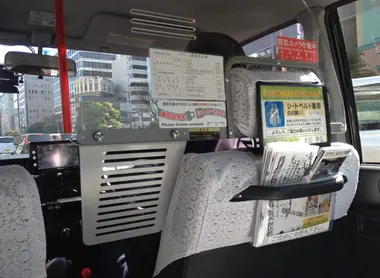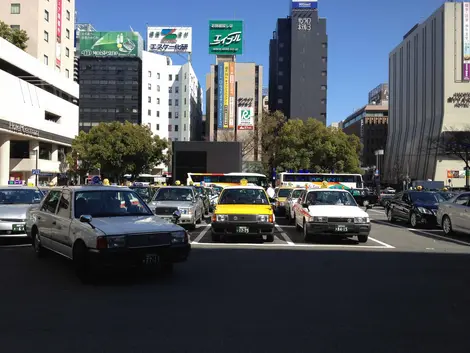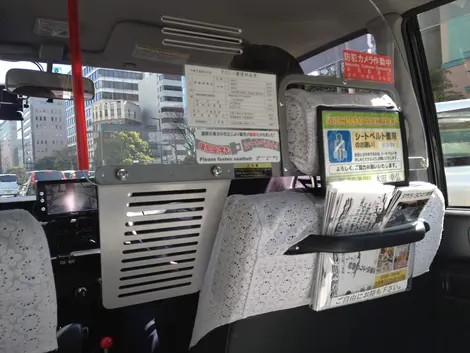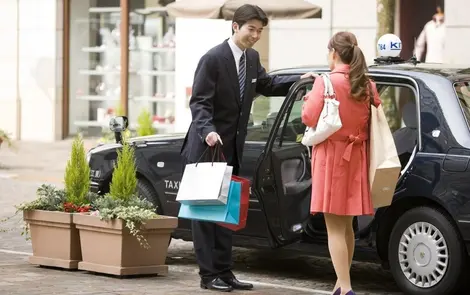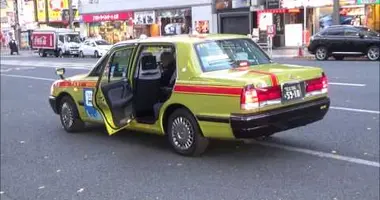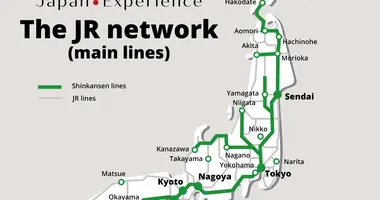How to Take a Taxi in Japan
- Published on : 02/12/2013
- by : A.M.
- Youtube
10 things to know
In Japan, cabs represent a comfortable, safe and convenient transportation option, particularly useful for foreign travelers. Although generally more expensive than public transport, they offer a valuable alternative when you're loaded down with luggage, traveling in a group, late at night, or to underserved destinations. Japanese cabs are renowned for their impeccable cleanliness, quality service and honest drivers. In this article, we'll detail everything you need to know about using cabs effectively during your stay in Japan.
When and why take a cab in Japan
Taking a cab in Japan is particularly useful in certain situations. If you're traveling with heavy or bulky luggage, especially between the airport or train station and your accommodation, a cab is a practical solution for avoiding the hassle of carrying suitcases in crowded subways.
Cabs also become indispensable late at night, when trains and subways stop running, generally between midnight and 5am. For the elderly, those with reduced mobility or those traveling with young children, cabs offer incomparable comfort. Finally, to reach destinations poorly served by public transport, especially in rural areas, cabs may be your only option.
Although more expensive than trains or buses, cabs can prove economical if you're traveling in a group of 3 or 4 people, enabling you to split the cost of the journey. For example, for a short trip around town, a cab shared between four passengers can cost the same as a subway ticket per person.
Recognizing and hailing a Japanese cab
Japanese cabs are easily recognizable in the urban landscape. They usually bear a green license plate and are equipped with an illuminated sign on the roof, lit up at night when the vehicle is available. The most common models are Toyota Crowns, often in black or yellow.
To find out if a cab is available, look out for the indicator on the windscreen: unlike Western habits, an available cab displays "空車" (kūsha) with a small red sign at the bottom right of the windscreen. When occupied, the indicator turns green and displays "賃走" (chinsō) or "実車" (jussha).
To hail a cab on the street, simply raise your hand when you see an available vehicle. In big cities like Tokyo or Osaka, you'll also find cab stands clearly marked near train stations, shopping centers and major tourist attractions with "TAXI" or "タクシー" signs. In this case, it's customary to queue up and wait your turn.
A special feature of Japanese cabs: the doors open and close automatically, operated by the driver from a control near the steering wheel. Don't try to manipulate them yourself, to avoid damaging the mechanism.
Understanding fares and payment methods
Cab fares in Japan vary from city to city and company to company, but generally follow a similar structure. In Tokyo, the starting price is around 410 yen for the first kilometer, while in other cities, the basic package can cover the first two kilometers for around 700 yen.
Beyond this initial distance, the meter increases by increments: in Tokyo, count on an additional 90 yen for every 280 meters covered or every 105 seconds of waiting time. A 7-kilometer journey in the capital generally takes 25 minutes and costs between 2,500 and 3,000 yen during the day.
Please note that fares increase by 20% between 10pm and 5am. What's more, any toll charges are the passenger's responsibility. Some popular routes, especially to airports, may have fixed fares.
To estimate the price of a journey, you can consult the Taxi Auto Fare website, which also offers a mobile version.
As far as payment is concerned, although more and more cabs accept credit cards, it is advisable to pay in cash, especially in rural areas. If you wish to pay by card, check that your card logo appears on the cab window, and note that a minimum amount (usually 5,000 yen) may be required. In larger cities, some cabs also accept prepaid cards, such as Suica or Pasmo.
Unlike other countries, tipping is neither expected nor accepted in Japan. Nor is it customary to negotiate the fare.
Etiquette in Japanese cabs
Respecting Japanese cab etiquette contributes to a pleasant experience for all. Here are the essential rules to know:
First, let the driver handle the doors. Cab doors open and close automatically; trying to manipulate them could damage the mechanism and would be considered impolite.
When you get into a cab, take a seat in the back. The front passenger seat is generally only used when four people are traveling together. Please note that Japanese cabs do not accept more than four passengers at a time.
Smoking is strictly forbidden inside cabs, unless otherwise indicated. Similarly, avoid eating or drinking, and keep your voice low when conversing with fellow passengers.
Japanese cab drivers are known for their professionalism and courtesy. They usually wear a suit, white gloves and sometimes a uniform cap. You'll often notice lace on the seats and headrests, testifying to the care taken with the vehicle's interior.
Finally, if you're very drunk, drivers have the right to refuse to pick you up. Try to maintain a respectful and dignified attitude, even after a festive evening.
Communicating with your driver despite the language barrier
Communicating with cab drivers can be a challenge for foreign travelers, as it's rare to come across an English-speaking driver, especially in less touristy areas. Fortunately, there are several ways of overcoming this language barrier.
The most effective method is to prepare the address of your destination in Japanese in advance. You can ask your hotel to write down the address on a piece of paper, or use a map or guidebook to indicate your destination precisely. Many travelers also use their smartphones to show the address in Japanese.
Here are some useful phrases that may help:
- 〇〇に行きたいんですが。(〇〇ni ikitain desu ga) - I want to go to 〇〇.
- どれぐらいかかりますか。(Dore gurai kakarimasu ka) - How long will it take?
- 〇〇まではいくらですか。(〇〇made wa ikura desu ka) - How much does it cost to go to 〇〇?
- この住所までお願いします。(Kono jūsho made onegaishimasu) - Take me to this address, please.
- ここ(まで)で大丈夫です。(Koko (made) de daijoubu desu) - You can stop here.
- クレジットカードで払えますか。(Kurejitto-kādo de haraemasu ka) - Can I pay with a credit card?
Some initiatives have been put in place to facilitate communication with tourists. In Osaka, for example, an English-speaking cab service identified by an "International Visitors Taxi" sticker has been tested. In Tokyo, the main cab association has launched the "TSTiE" (Tokyo Sightseeing Taxi in English) initiative, with drivers who score well on the TOEIC English exam.
In big cities like Tokyo, most drivers have GPS and can take you to your destination even if verbal communication is limited.
Cab booking apps and services
To make your cab journeys easier in Japan, a number of applications and booking services are available. These tools can considerably simplify the cab booking process, especially when faced with language barriers.
The GO Taxi app is particularly recommended. It works like Uber, allowing you to hail cabs at your location. It's a good idea to download it and set up your credit card before you leave. Even if you can't add your card to the app, you can create an account and use it to hail cabs, then pay in cash.
Other popular apps include S.RIDE, Uber, and DiDi, all of which offer English interfaces after download. Note, however, that ride-sharing apps like Uber are not as widespread in Japan as in other countries.
If you prefer to book by phone, you can contact companies like Nihon Kotsu or Taxi Service in Tokyo, which offer services in English.
In tourist areas like Kyoto, private cab services with English-speaking guides are available. Many companies in the Tokyo area also offer tailor-made cab tours.
For journeys to and from airports, major airports such as Narita and Haneda offer flat-rate cab services to most parts of Tokyo. These can be cheaper than metered fares for longer distances.
Alternatives to cabs for your travels in Japan
While cabs offer comfort and convenience, Japan has one of the world's most efficient public transport networks, often more economical for your daily commute.
Trains and subways are the preferred means of transport for the Japanese. The rail network, mainly managed by Japan Railways (JR), serves almost all points of tourist interest. In major cities, subways are an efficient complement to this network. To optimize your travels, consider purchasing a prepaid card such as Suica or Pasmo, which saves you having to buy individual tickets.
Long-distance buses are an economical alternative to trains, especially if you're traveling on a budget. Although the journeys are longer, the buses are generally comfortable. Some companies even offer overnight buses, allowing you to save on one night's accommodation.
For longer distances, domestic flights can be fast and sometimes affordable, especially with low-cost airlines such as Jetstar Japan, Peach Aviation and Skymark Airlines.
Car rental is a good option for exploring rural areas, but can be costly due to fuel, tolls and parking fees. Please note that an international driving license is required.
Last but not least, in small and medium-sized towns, bicycle rental is an economical and enjoyable way to explore the neighborhoods. Rates are generally affordable, at around 1,000 yen per day.
To choose the means of transport best suited to your needs, consider your budget, the number of people traveling together, your time constraints and the accessibility of your destination.

